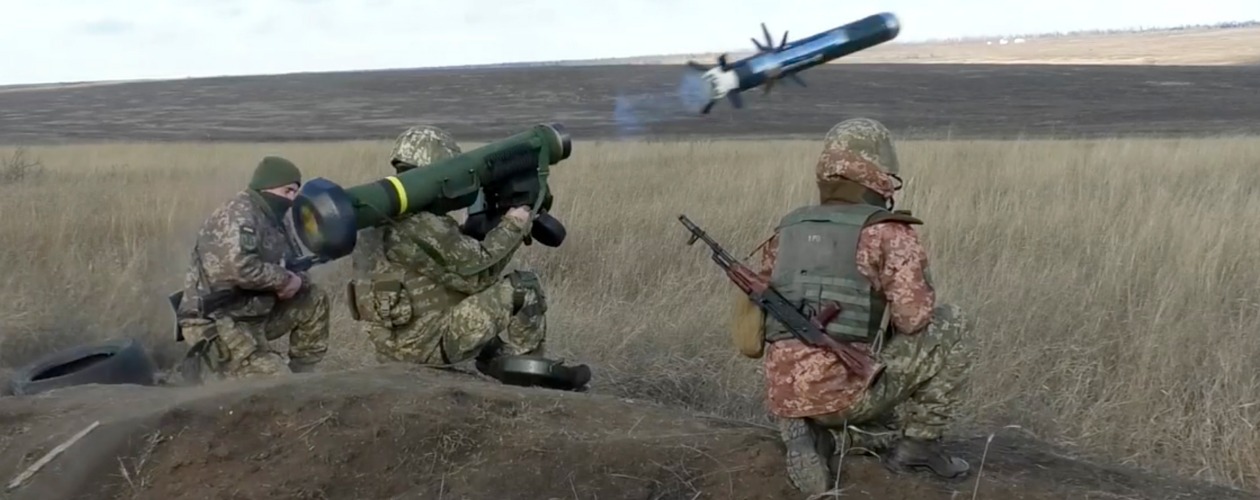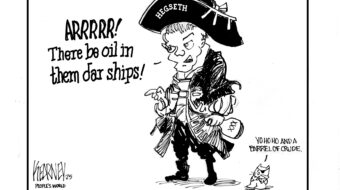
The world is fearful of possible war once again. This time the hotspot is Ukraine, with the accompanying crisis there and the fact that two of the adversaries, the U.S. and Russia, are the two largest nuclear powers on Earth.
Obviously not good! But there is a way out of the crisis and a way to preserve the peace. We can only arrive at a solution, however, if we understand how the situation got to this point and who it is that’s responsible for getting us here.
The dominant outlets of the U.S. corporate press—whether conservative or liberal in their outlook; on television, online, or in print—are ringing alarm bells, saying Russian President Vladimir Putin has amassed troops and is plotting an invasion of his neighbor. Why?

Well, according to the New York Times, nobody knows. The paper quotes U.S. Secretary of State Antony Blinken, who, acting bewildered, says, “It’s not clear what Russia’s central demand is.” The only reason offered by the pundits is that Putin is aggressive and irrational.
That paltry non-explanation is anything but credible. A deeper look at history and recent events reveals that it is the West, by pursuing a long-term policy of NATO aggression, that bears responsibility for the crisis now gripping eastern Europe.
Who’s invading whom?
It is helpful to understand that all countries, the U.S. included, have core strategic interests that, if violated, can force them into taking military action and going to war.
To understand the Russian view of NATO’s possible expansion and placement of weapons or troops in Ukraine—which multiple U.S. administrations, including the current one, have threatened—a simple thought experiment is useful. Since the declaration of the Monroe Doctrine, the U.S. has declared the entirety of the Western Hemisphere as a core strategic interest. It would never tolerate Russian or Chinese weapons being placed in countries directly on its border, such as Canada or Mexico. But a situation just like that is what Russia’s leaders fear.
Russia cannot tolerate NATO weaponry (like the U.S.-managed nuclear weapons NATO has in Germany) to be stationed right along its borders in Ukraine. Missiles that can reach Moscow in five minutes or less are a definite no-no.

It is also useful to keep in mind a bit of history regarding Ukraine and Russia. They have historically been closely linked. The Russian state began centuries ago in Kiev, the present-day capital of Ukraine, and in modern times, both were part of the Soviet Union. During those years, Ukraine had a higher standard of living than any of the other Soviet Republics, including Russia.
Then and now, 40% or more of the population in Ukraine was and is Russian. The productive industrial part of Ukraine in the east is almost entirely Russian by language and ethnicity. Millions of families in the country are headed by parents of different ethnicities, one of whom is Ukrainian and the other Russian. Even Volodymyr Zelensky, the president of Ukraine today, was a well-known Russian-speaking comedian before he ran for that office. He started speaking Ukrainian, however, after he was elected. The short story is that there should be no ethnic basis for hostility between Ukraine and Russia.
Since the collapse of the Soviet Union, the aim of the U.S. and NATO, along with the militarist wing of the European Union, has been to separate Ukraine from Russia, making it a bulwark on Russia’s border. Russia, of course, has declared that this simply will not happen.
The aim of grabbing Ukraine is connected to overall NATO and EU expansion eastward which began first with grabbing the Czech Republic and Poland. Both of these countries were formerly part of the Soviet-led Warsaw Pact military alliance, which was formed to defend against NATO during the Cold War.
In the case of Ukraine, as is most often the case with such NATO militarism, the operation is disguised as one intended to “spread democracy.” So in the case of Ukraine, the idea spread far and wide in the Western corporate media and from the governments involved over the last few years has been that Ukraine was not being separated from Russia by a fascist coup backed by the West but rather by an “Orange Revolution” in which democracy was the aim.
We know, of course, that once the so-called “Orange Revolution” happened, political parties—including left and progressive parties like the Communist Party—were banned, use of the Russian language inside Ukraine was banned, hundreds of trade unionists were killed, and the poisoned food grown in the radiation-contaminated Chernobyl region was back on sale for consumption by Ukrainians.
The “democratic” government turned control over the police and the military to historically well-known fascist organizations. They remain in the control of those fascist organizations today. “Promoting democracy” is the excuse the U.S. always uses when it wants to topple a regime it does not support. Examples are numerous—Grenada, Chile, Cuba, Iraq, Syria—and the list could go on.
NATO’s eastward march
In 1999, NATO—in violation of U.S. assurances made years earlier at the end of the Cold War—took the first step of its own “invasion” by expanding into Poland and the Czech Republic. Russia, totally devastated economically following the destruction of the Soviet Union, was too weak at the time to mount any serious opposition.
When the West saw that this worked and that they could get away with it, in 2004 they moved into the Baltic states of Estonia, Lithuania, and Latvia—former Soviet Republics. Keep in mind that U.S. troops and weapons are now in all these countries, under the guise of those NATO deployments. German troops are there too, entering those countries for the first time since the USSR drove out Nazi forces from all those places as it shut down networks of concentration camps that they operated.
The “democracy” that has resulted in these countries is dubious indeed. Poland is practically a fascist dictatorship today. In Latvia, it is illegal to teach anything about the death factories that Hitler’s forces ran when they occupied the country. There, too, the Communist and left other political parties are banned. It should be noted that all these right-wing measures are supposedly forbidden by the EU constitution but ignored by the leadership of the EU countries.

Keep in mind that war was the result of this aggressive NATO expansionism. In 2008, the West pushed into Georgia, another former Soviet Republic, assuring the right-wing autocratic government there that it could count on Western support. U.S. Sen. John McCain was among those who went to Georgia to so embolden the government there that it began slaughtering thousands of Russian-speaking citizens in the north of Georgia, causing tens of thousands of them to flee across the border into Russia, saddling that country with a sudden refugee crisis. The Georgian right-wingers did not cease until Russia sent in troops to quell the attacks. The Western media, of course, described that Russian action as an “invasion.”
Ukraine’s descent toward fascism
Back to Ukraine and fast forward to November 2013. The elected president of Ukraine at the time, Victor Yanukovych, was negotiating with the EU to move Ukraine closer to the EU but not by directly joining. He wanted to broker an economic deal that would benefit Ukraine, the EU, Russia, and even the IMF, if possible. Via Ukraine, the EU could access Russian energy resources and Russia would gain new customers. As the intermediary, Ukraine could win financially by playing the pipeline middle man and getting cheaper gas for itself. Yanukovych’s rationale: Why not have a cooperative peaceful deal beneficial to all parties?
The all-or-nothing people in the West who wanted to control Ukraine, however, said no. The EU wanted Ukraine to keep paying inflated prices and to stick to a burdensome debt repayment schedule. Putin then offered Ukraine a deal much better than what the EU was offering—Russian gas for up to a third less and help paying off debt. Yanukovych, who did not want to impose the austerity on his people that the EU was demanding, accepted Putin’s offer.
In response, the nationalist right wing in Ukraine, led by openly fascist organizations, began to whip up protests. Yanukovych overreacted with police violence against demonstrators, and many were killed. Things spiraled out of control, and he fled to Russia as a fascist coup openly backed by the U.S. seized control in Kiev under the guise of “restoring law and order.” Again, EU and NATO expansionist desires were resulting in bloodshed.

German and French lawmakers actually went to Ukraine to try to talk to the fascists and organize elections, but the fascists refused for quite a while and, maintaining control, turned over the police and the army to their own fascist organizations. They wanted to make sure that this could be done before there was even the appearance of democracy in Ukraine.
The Russians then closed checkpoints in Crimea, a peninsula in the Black Sea that had been administered by Ukraine since the 1950s despite the fact that 90% of the population was Russian. This arrangement had been agreed to in the Soviet days because of Crimea’s physical proximity to Ukraine. Vast amounts of Ukrainian territory separate Crimea from the rest of Russia. Under the extension of that treaty when the USSR was dismantled, Russian troops remained in Crimea in order to protect the nuclear-capable base that was there.
The much-hyped Russian “invasion” of Crimea in 2014 then was actually an effort to close off the area and protect it and the nuclear base from the fascists running Kiev. The Russian troops were already there with the agreement of Ukraine.
A vote was held shortly after and the people of Crimea chose to return to the Russian administration. Making up the overwhelming majority of the population, how could they vote otherwise as they watched fascist Ukrainian troops killing Russians in eastern Ukraine and a Ukrainian government forbidding the use of their own language?
As volatile as the situation was at the time, the Russians did not follow this with an invasion of Ukraine. What they did essentially was tell the West to back off. Putin did not want a wider war. What Russia’s leaders were refusing to accept was NATO being planted on their border with dangerous weapons pointing at them.
Russia does not want war
Continued efforts after those events by NATO and the EU to push eastward and take in Ukraine have been nothing less than both dangerous and criminal. Those policies have endangered the whole world.
Even Friday, it was announced by Blinken that, after an initial meeting with the Russians, talks will continue. It is clear the Russians do not want to invade Ukraine. They do have troops along the border with Ukraine, but those troops are on Russian territory and are positioned as leverage to protect their borders and stop NATO expansionism.

In figuring out a solution, we must not get sidetracked with issues about Putin as a person. He is an autocrat and anything but a fan of democracy. None of this changes the fact, however, that all political trends in Russia support him on the Ukraine issue. This includes his leading political opponents, including Alexei Navalny, former Soviet leader Mikhail Gorbachev, and the Communist Party of the Russian Federation—not to mention the people on the streets. If St. Nicolas himself were running the government of Russia right now, he would probably also be strongly opposed to allowing NATO to advance into Ukraine.
Back to the issue of vital strategic interests. Keeping dangerous weapons in service of the West away from its borders is in the vital strategic interests of Russia. What happens in Ukraine is of critical importance to the survival of Russia. From Napoleon to the Kaiser to Hitler, Russia has been invaded too many times from Europe, and it is understandably determined to maintain a militarily non-aligned buffer zone on its border.
By contrast, Ukraine is emphatically not in the strategic interests of the United States. The U.S., in fact, would benefit from peace in that region and certainly not benefit in any way if there were a war involving the two big nuclear powers. Nor would Ukraine benefit from such a war. Nor would Russia or the rest of the world.
This situation, which took so many years to develop, can only be solved in one way. It is a simple solution: NATO and the U.S. must promise that Ukraine will never become a part of NATO. That is the indispensable first step.
It’s what was agreed to as part of the efforts to end the Cold War.
It’s what Putin and Yanukovych wanted when they tried to broker an EU-Ukraine-Russia-IMF deal all those years ago. How stupid and dangerous it was for the U.S. to say no.
End all NATO expansion eastward!
C.J. Atkins contributed to this article.
MORE PEOPLE’S WORLD COVERAGE ON UKRAINE:
> Dark days for Ukraine’s left
> U.S. sends forces to train Ukraine National Guard, communists repressed
> U.S. and NATO play with fire in their latest anti-Russia campaign
> The facts about Ukraine that no one mentioned during the impeachment trial
> Ukrainian rightists burn alive 39 at Odessa union building










